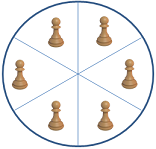Batch 3 - Class 133 - Invariants 2
Pre-Class Problem:
- Play a game where the kids start with numbers 1 to 20 on the board. At each step, you erase two numbers and then replace those with a+b-1. Let them do this for 19 steps, and guess the final number as 191. Ask the kids to figure out what's happened
- Answer: The order of choosing numbers is unimportant. The final number is sum of all numbers - number of steps. So 210 - 19 = 191
- What is the invariant?Answer: Sum of all numbers - number of numbers (with 20 numbers it is 191, but at the end as well it is 191, and since there is only one number, the number must be 190)
Attendance: Smiti, Muskaan, Khushi, Arnav, Anishka, Anshi, Ahana, Damini, Siddhant, Palak
Class Notes: (MC Chap 12)
Revise notion of invariance
- A statement that does not change from one step to another in a problem
- Must be relevant to solving the problem (for example, "Sum of first five whole numbers is 15" is an invariant for all problems, but it doesn't help solve any problem)
- Is not a constant (for example, "the number of birds" in the sparrow/tree problem - again doesn't help solve the problem)
- Parity is a special case of invariance
- Revision Example: There are six sectors of a disc, with a pawn in each sector. At each step, you take two pawns and move them each to any of the adjacent sectors. Can you get all pawns in the same sector?

- Answer: If you number the six sectors 1..6 in order, then at each step the odd/even parity remains the same. Starting sum is 21, i.e. odd. Getting all six pawns in same sector requires even parity. Hence it is not possible.
- Note that fitting an invariant doesn't guarantee a solution in many cases. Not fitting one can guarantee lack of a solution. (Again, think about irrelevant invariants)
- Now we take the same numbers, and everytime we erase two numbers, we replace that with a+b+ab. What's the final number?
- Whats the invariant? Hint: Can you think of invariant by looking at (a+1)(b+1)...
- Answer: (a+1)(b+1)... is the invariant, so final answer is 24-1=23
- There is an 8x8 table, all squares are white except that one of the squares is colored black. At any step, you take a row or column, and toggle the colors of all squares in that row/column. Prove that you cannot make the entire table white
- Answer: Consider the parity of black colored squares on the table - its an invariant
- Solve the same problem for a 3x3 table with one of the corners blackAnswer: Consider the parity of black colored squares amongst four corners - its an invariant
- Solve the 8x8 table problem if initially the four corners are colored black
- Hint: Go back to the initial problem - generalize to "if there are odd number of black squares on an even grid, it can't be converted to an all-white grid"
- Answer: Consider the 2x2 square in upper left corner. That has odd parity of black colored squares, which is an invariant
Homework Problem
- In a special chess game played on 10x10 board, a "Camel" can do a 1,3 move i.e. move 1 square in any direction, and then 3 squares in a perpendicular direction. Is it possible for the camel to move to an adjacent square through a sequence of moves?
- Answer: No. The camel always remains on the same colored square
References:
Mathematical Circles (Russian Experience), by Dmitri Fomin, Sergey Genkin, Ilia Itenberg